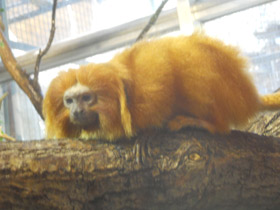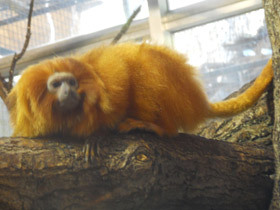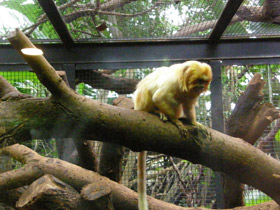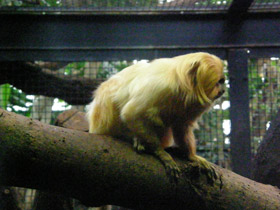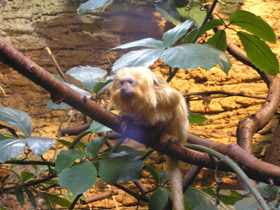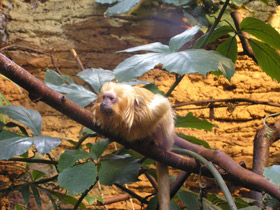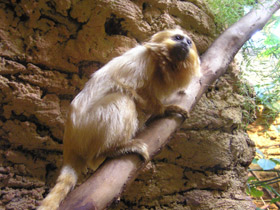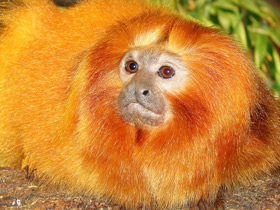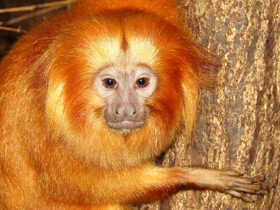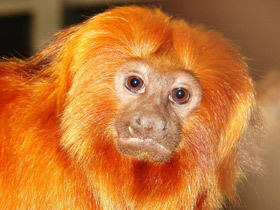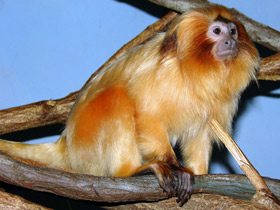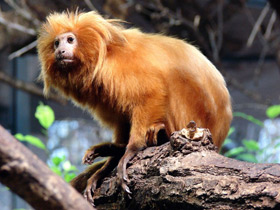The golden lion tamarin or the golden marmoset (Leontopithecus rosalia)
Golden lion tamarin видео
The golden lion tamarin (Leontopithecus rosalia; Portuguese: mico-leão-dourado [ˈmiku leˈɐ̃w do(w)ˈɾadu, - liˈɐ̃w -]), also known as the golden marmoset, is a small New World monkey of the family Callitrichidae. Endemic to the Atlantic coastal forests of Brazil, the golden lion tamarin is an endangered species. The range for wild individuals is spread across four places along southeastern Brazil, with a recent census estimating 3,200 individuals left in the wild and a captive population maintaining about 490 individuals among 150 zoos.
Appearance and nutrition
Leontopithecus rosalia is a species of platyrrhine primate in the family Callitrichidae. It is the largest member of the family Callitrichidae, weighing up to 1 kg and averaging 0.5 m in length with a tail of 40 cm. This monkey is named for its remarkably shiny and beautiful golden fur. Rosalias feed on fruit, resin and nectar, but also eat flowers, insects, lizards and frogs.
Distribution
Leontopithecus rosalia is one of the rarest mammals in the wild: only about 400 animals remain, most of which live in a very limited area of Brazil. The species is listed in the International Stud Book and all Leontopithecus rosalia kept in captivity are owned by the species' conservation programme and controlled by the Brazilian government.
Behaviour and ecology
The golden lion tamarin is active for a maximum of 12 hours daily. It uses different sleeping dens each day. By frequently moving their sleeping nests around, groups minimize the scent left behind, reducing the likelihood of predators finding them. The first activities of the day are traveling and feeding on fruits. As the afternoon nears, tamarins focus more on insects. By late afternoon, they move to their night dens. Tamarin groups use hollow tree cavities, dense vines or epiphytes as sleeping sites. Sites that are between 11 and 15 m (36 and 49 ft) off the ground are preferred. The golden lion tamarin tends to be active earlier and retire later in the warmer, wetter times of the year as the days are longer. During drier times, it forages for insects longer as they become scarcer.
Golden lion tamarins are characterized by using manipulative foraging under tree barks and epiphytic bromeliads. Their sites of foraging are usually distributed around their home ranges, which are large territories (averaging 123 hectares) in which multiple foraging sites are located, to find sufficient resources over long periods of time. These areas are sufficient in size that even if there is overlap between the home range of two different groups, the interactions are minimal due to the distribution of the foraging sites (they spend 50% of their time in approximately 11% of their home range).
The golden lion tamarin has a diverse, omnivorous diet consisting of fruits, flowers, nectar, bird eggs, insects and small vertebrates. They rely on microhabitats for foraging and other daily activities and tamarins will use bromeliads, palm crowns, palm leaf sheaths, woody crevices, lianas, vine tangles, tree bark, rotten logs, and leaf litters. The golden lion tamarin uses its fingers to extract prey from crevices, under leaves, and in dense growth; a behavior known as micromanipulation. It is made possible by elongated hands and fingers. Insects make up to 10–15% of its diet. Much of the rest is made of small, sweet, pulpy fruits. During the rainy season, the golden lion tamarin mainly eats fruit; however, during drier times, it must eat more of other foods like nectar and gums. Small vertebrates are also consumed more at these times as insects become less abundant.
Social structure
Golden lion tamarins are social and groups typically consist of 2-8 members. These groups usually consist of one breeding adult male and female but may also have 2–3 males and one female or the reverse. Other members include subadults, juveniles and infants of either sex. These individuals are typically the offspring of the adults. When there is more than one breeding adult in a group, one is usually dominant over the other and this is maintained through aggressive behavior. The dominance relationship between males and females depends on longevity in the group. A newly immigrated male is subordinate to the resident adult female who inherited her rank from her mother. Both males and females may leave their natal group at the age of four, however females may replace their mothers as the breeding adult, if they die, which will lead to the dispersal of the breeding male who is likely her father. This does not happen with males and their fathers. Dispersing males join groups with other males and remain in them until they find an opportunity to immigrate to a new group. The vast majority of recruits to groups are males. A male may find an opportunity to enter into a group when the resident male dies or disappears. Males may also aggressively displace resident males from their group; this is usually done by two immigrant males who are likely brothers. When this happens, only one of the new males will be able to breed and will suppress the reproduction of the other. A resident male may also leave a vacancy when his daughter becomes the breeding female and he must disperse to avoid inbreeding. Golden lion tamarins are highly territorial and groups will defend their home range boundaries and resources from other groups.
Tamarins emit "whine" and "peep" calls, which are associated with alarm and alliances respectively. "Clucks" are made during foraging trips or during aggressive encounters, whether directed at conspecifics or predators. "Trills" are used to communicate over long distances to give away an individual's position. "Rasps" or "screeches" are usually associated with playful behavior. Tamarins communicate through chemicals marked throughout their territories. Reproductive males and females scent mark the most and their non-reproductive counterparts rarely do so. Dominant males use scent marking to show their social status and may suppress the reproductive abilities of the other males.
Reproduction
Leontopithecus rosalia live in groups of 2 to 8 animals, including the breeding pair and their offspring of different ages. Pregnancy lasts about 5 months and usually culminates in twins. Until the offspring are three weeks old, they move on their mother's back, but then all responsibilities for the upbringing of the newborn pass to the father. From then on, the head of the family tirelessly carries the calves on his back for almost two months, handing them back to their mother only when they are breastfed.
Ecosystem roles
The golden lion tamarin has a mutualistic interaction with 96 species of plants found in the Atlantic Forest. This interaction is based on seed dispersal and food sources for the tamarins. The tamarins show repeat visits to those plants with abundant resources. They tend to move around their territories, and therefore, seeds are dispersed to areas far from the parent shadow, which is ideal for germination. Their seed distribution is important to forest regeneration, and genetic variability and survival of endangered plant species.









